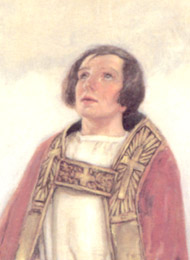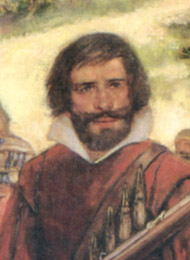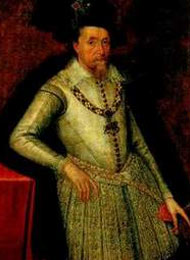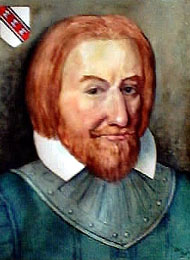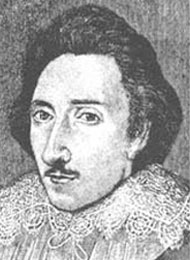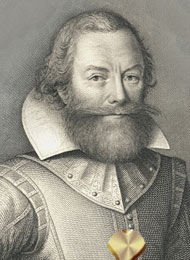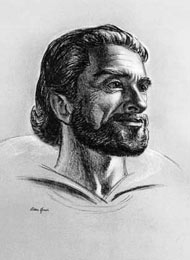Born in 1552, Richard Hakluyt (c. 1552 - November 23, 1616) was an English writer, famous for his Voyages, which provided William Shakespeare and others with material, and was a foundation for the travel literature genre. The Hakluyts were of Welsh extraction, and appear to have settled in Herefordshire around the 13th century.
Hakluyt was born in Hereford and educated at Westminster School, where he was a Queen's Scholar; while there he visited to his cousin and namesake, Richard Hakluyt of the Middle Temple, whose conversation, illustrated by "certain bookes of cosmographie, an universall mappe, and the Bible," made young Hakluyt resolve to "prosecute that knowledge, and kind of literature."
Entering Christ Church, Oxford, in 1570,"; his exercises of duty first performed," he set out to read all the printed or written voyages and discoveries that he could find.
He took his BA in 1573/4, and shortly after taking his MA (1575), he began giving public lectures in geography, the first to show "both the old imperfectly composed and the new lately reforme mappes, globes, spheares, and other instruments of this art."
As a result of his research, he wrote and published, in 1582, his Divers Voyages Touching the Discoverie of America and the Ilands Adjacent unto the Same, Made First of all by our Englishmen and Afterward by the Frenchmen and Britons.
He went on to produce The Principall Navigations, Voiages and Discoveries of the English Nation...in 1589, using eye-witness accounts as far as possible.
Hakluyt's first work brought him to the notice of Lord Howard of Effingham, and so to that of Sir Edward Stafford, Lord Howard's brother-in-law.
At the age of thirty, being acquainted with" the chiefest captaines at sea, the greatest merchants, and the best mariners of our nation," he was selected, as chaplain to accompany Stafford, now English ambassador at the French court, to Paris (1583).
In accordance with the instructions of Secretary Francis Walsingham, he occupied himself chiefly in collecting information of the Spanish and French movements, and" making diligent inquirie of such things as might yield any light unto our westerne discoverie in America."
Although he only visited the Continent once during his life, he was angered to hear, in Paris, the limitations of the English, in terms of travel, being discussed.
The first-fruits of Hakluyt's labours in Paris are embodied in his important work entitled A particuler discourse concerning Wesierne discoveries written in the yere 1584, by Richarde Hackluyt of Oxforde, at the requeste and direction of the righte worshipfull Mr Walter Ragfly before the comynge home of his twoo barkes.
This long-lost manuscript was at last printed in 1877. Its object was to recommend the enterprise of planting the English race in the unsettled parts of North America.
Hakluyt's other works consist mainly of translations and compilations, relieved by his dedications and prefaces, which last, with a few letters, are the only material we possess out of which a biography of him can be framed.
Hakluyt revisited England in 1584, laid before Queen Elizabeth a copy of the Discourse " along with one in Latin upon Aristotle's Politicks," and obtained, two days before his return to Paris, the grant of the next vacant prebend at Bristol, to which he was admitted in 1586 and held with his other preferments till his death.
While in Paris Hakluyt interested himself in the publication of the manuscript journal of Laudonniere, the Histoire notable de la Florida, edited by Bassanier (Paris, 1586, 8vo.).
This was translated by Hakluyt and published in London under the title of A notable historie containing foure voyages made by certayne French captaynes into Florida (London, 1587, 4t0.)
The same year De orbe novo Petri Martyris Anglerii decades octo illustratae labore et industria Richardi Hackluyti saw the light at Paris.
This work contains the exceedingly rare copperplate map dedicated to Hakluyt and signed F.G. (supposed to be Francis Gualle); it is the first on which the name of "Virginia " appears.
In 1588 Hakluyt finally returned to England with Lady Stafford, after a residence in France of nearly five years. In 1589 he published the first edition of his chief work, The Principall Navigations, Voiages and Discoveries of the English Nation (101., London, 1 vol.)
In the preface to this we have the announcement of the intended publication of the first terrestrial globe made in England by Molyneux.
In 1598-1600 appeared the final, reconstructed and greatly enlarged edition of The Principal Navigations, Voyages, Traffiques and Discoveries of the English Nation (fol., 3 vols.) Some few copies contain an exceedingly rare map, the first on the Mercator projection made in England according to the true principles laid down by Edward Wright.
Hakluyt's great collection, though but little read, has been truly called the "prose epic of the modern English nation."; It is an invaluable treasure of material for the history of geographical discovery and colonization, which has secured for its editor a lasting reputation.
In 1601 Hakluyt edited a translation from the Portuguese of Antonio Galvano, The Discoveries of the World (4to., London).
In the same year his name occurs as an adviser to the East India Company, supplying them with maps, and informing them as to markets. Meantime in 1590 (April 20th) he had been instituted to the rectory of Witheringsett-cum-Brockford, Suffolk.
On May 4, 1602, he was installed as prebendary of Westminster, and in the following year was elected archdeacon of Westminster. In the licence of his second marriage (March 30, 1604) he is described as one of the chaplains of the Savoy, and his will refers to chambers occupied by him there up to the time of his death; in another official document he is styled D.D. In 1605 he secured the prospective living of James Town, the intended capital of the intended colony of Virginia.
This benefice he supplied, when the colony was at last established in 1607, by a curate, one Robert Hunt. In 1606 he appears as one of the chief promoters of the petition to the king for patents to colonize Virginia.
He was also a leading adventurer in the London or South Virginia Company. His last publication was a translation of Hernando de Soto's discoveries in Florida, entitled Virginia richly valued by the description of Florida her next neighbour (London, 1609, 4to.)
This work was intended to encourage the young colony of Virginia; to Hakluyt, it has been said, "England is more indebted for its American possession than to any man of that age."
One may notice that it was at Hakluyt's suggestion that Robert Parke translated Mendoza's History of China (London, 1588-1580) and John Pory made his version of Leo Africanus (A Geographical History of Africa, London, 1600).
Hakluyt died in 1616 and was buried in Westminster Abbey (November 26); by an error in the abbey register his burial is recorded under the year 1626. Out of his various emoluments and preferments (of which the last was Gedney rectory, Lincolnshire, in 1612) he amassed a small fortune, which was squandered by a son.
A number of his manuscripts, sufficient to form a fourth volume of his collections of 1598-1600, fell into the hands of Samuel Purchas, who inserted them in an abridged form in his Pilgrimes (1625-1626, fol.)
Others are preserved at Oxford (Bib. Bod. manuscript Seld. B. 8) which consist chiefly of notes gathered from contemporary authors.
The Hakluyt Society was founded in 1846 for printing rare and unpublished voyages and travels, and continues to publish two or three volumes per year.
Geographer, born in Hertfordshire, SE England, UK. He studied at Oxford, where he lectured in geography, and was ordained some time before 1580. He wrote widely on exploration and navigation, notably his Principal Navigations, Voyages, and Discoveries of the English Nation (1589; 3 vols, 1598-1600.)
He also introduced the use of globes into English schools. Made a prebendary of Westminster in 1602, he is buried in Westminster Abbey. The Hakluyt Society was instituted in 1846. |

